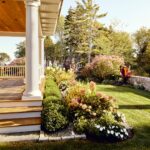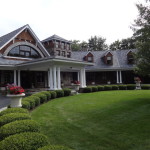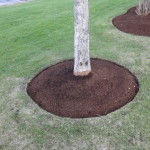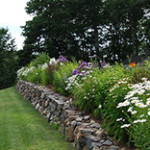Maintenance-free landscaping is a goal for many of our customers living busy lifestyles, and the solutions we share at Terrapin Landscapes go way beyond planting perennials instead of annuals. To see how we turn our deep knowledge of the Maine ecosystem and timeless landscape design trends into easy-care outdoor planting and landscaping plans, read on! Less lawn, more meadow Here is a hard truth: there are few things on your property that take as much time and effort to maintain as a uniform, green grass lawn. For all its popularity, plush and inviting turf is awfully time-consuming and resource-intensive to keep up. Regular watering in the warmer months. Weekly mowing and trimming. Pulling out dandelions, seeding patchy spots, keeping the kids or your pets from burning spots in the grass or digging divots … if you are looking for a plant-it-and-leave-it landscaping solution, a lawn just isn’t it. Terrapin Landscapes knows how much Mainers love their lawns. (We love playing catch and croquet and running barefoot through sprinklers in the summer, too!) And most of our clients want some kind of lawn expanse on their property. If you have the available space and enough sun, however, we often recommend...
Landscaping with Dogs in Mind: Making Your Yard Work for Everyone in Your Family
The Terrapin Landscapes team are true dog lovers and nothing makes us happier than clients who come to us hoping to make more dog-friendly landscape decisions. Hardscaping and landscaping for dogs means thinking about safety, usability, and aesthetics from your pup’s perspective—and no one turns landscapes and hardscapes into dogscapes quite like Terrapin. #1: PATHWAYS The best dog-friendly backyard designs create opportunities for dogs to do what they do best— protect their people—while making sure that dogs are contained and protected while they play outdoors. For that reason, most dog-friendly landscapes incorporate some form of fencing around all or part of the yard. Traditional fences can frustrate dogs by keeping them from monitoring what they see as potential threats. No matter what their breed, dogs are, to some degree, territorial. They naturally want to keep a watchful eye on your property and your family. Our designers can show you attractive fencing options that offer privacy while providing ways for your dogs to see passersby and keep a wary eye on the wider world. We’ve even helped clients create “portholes” in fencing their pups can peek through! Terrapin Landscapes designers know that planting near fence lines will also frustrate...
Maine Landscaping Design Trends from the Experts
There may be snow and ice all around us, but the residential landscaping professionals at Terrapin Landscapes are already meeting with residential and commercial clients to plan projects and improvements to start this spring. Front yard landscaping ideas, pool landscaping ideas, driveway entrance ideas, walkway ideas—our offices are overflowing with sketches, swatches, and samples. Looking for inspiration for your garden design or residential landscaping project? Our landscape planners are seeing some clear (and exciting) trends for 2020—and we’re sharing them below! #1: MINIMIZING ENVIRONMENTAL IMPACT Terrapin Landscapes would never tackle a project without considering its environmental impact. From minimizing water and energy usage to avoiding invasive plantings to prioritizing sustainable, renewable materials and solutions, green thinking is a given at Terrapin. So where are low-impact landscaping trends going in 2020? While water supply is not as much of a concern in Maine as water purity, we are seeing a growing number of clients and customers asking great questions about water retention, water recycling, and water runoff during the design process. An overall concern for water quality is driving more residential landscaping decisions in the coming year and our backyard designers are being asked to design architectural water features like...
Lawn Care Myths
What’s true and what’s not? These are the Top 5 lawn care myths that we want to address once and for all. Myth #1: The best time to plant grass seed is in the Spring. This is not true, especially in Maine. Unpredictable changes in Spring time daily temperatures could put your newly sowed grass seed at risk. A sudden cold spell could kill the tender new grass before it has a chance to harden off. A warm, dry spell could allow weeds that thrive in dry conditions to move in and overtake the new grass. The best time to sow new seed in Maine is in the fall when temperatures are more consistent, and competitive weeds like crabgrass are dormant. Myth #2: Golf courses cut their grass short, so I should do the same. Golf courses use sophisticated methods and very expensive machinery to maintain their turf. The proper mowing height for a healthy, drought resistant lawn is 3-3.5″ A good rule of thumb is to “mow high, mow often” or never remove more than 1/3 of the grass blade at one time. Myth #3: The products that lawn care companies use are dangerous and more powerful than what...
Proper Tree Mulching Techniques
Spring Cleanups are finally done and we have shifted into mulch mode here at Terrapin Landscaping. In this blog post, I would like to address the proper way to mulch a tree. Mulching is one of the most beneficial practices a homeowner can use for better tree health. The benefits of proper tree mulching are as follows: Helps reduce soil moisture lost through evaporation. Helps control weed germination and growth. Insulates soil, protecting roots from extreme summer and winter temperatures. Can improve soil biology, aeration, and drainage over time. Can improve soil fertility as certain mulch types decompose. Inhibits certain plant diseases Reduces the likelihood of tree damage from “weed whackers” . Gives planting beds a uniform, manicured look. As beneficial as mulch is, too much can be harmful. The recommended mulching depth is 2 to 4 inches. Unfortunately many landscapes are falling victim to a plague of over mulching. While organic mulches must be replenished over time, build-up can occur if reapplication outpaces decomposition or if new material is added simply to refresh color. Improper tree mulching often results in “mulch volcanoes.” “Mulch volcanoes” are excessive piles of mulch materials applied around the base of trees. Besides being unsightly, over-mulching...
Spring Lawn Care Tips
It might be still partially covered in snow, or a sore sight after the winter we have just endured here in Kennebunkport, but with a bit of work you can help bring your lawn back to life. You may see a fair amount of thatch. Thatch is a normal accumulation of organic matter. In small amounts the thatch layer is beneficial to your lawn as it is full of nutrients and microorganisms. In a healthy lawn the thatch layer could be up to 1 inch thick, but if the thatch has accumulated to more than 1 inch, you will need to remove it before you can attempt any other lawn care projects. This can be done with a good hand raking or with a dethatching machine. The reason for this is that anything you add, such as new seed or fertilizer, will simply sit on top of the thatch rather than getting into the soil. Once the lawn has been de-thatched you can add your fertilizer. This helps the lawn to recover from winter stress. Pre-emergent weed and crabgrass control should also be applied during this step. If you would like to find out more about maintaining a healthy lawn, or just have lawn...





